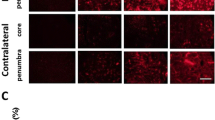Summary
This review focuses on the pathophysiological changes in acute cerebral ischemia, with special emphasis on disturbances of the cerebral blood flow (CBF) and the associated penumbra concept. Alternatively, the model of peri-infarct depolarization is demonstrated. Metabolic and molecular changes caused by cerebral ischemia and reperfusion are discussed, namely energy failure, release of glutamate with an excitatoric burst, calcium influx in neurons, generation of free radicals, activation of different proteases, disturbances of protein synthesis, induction of gene expression and apoptosis, loss of membrane integrity, edema formation and microvascular disturbances. In summary, the pathophysiological changes after focal cerebral ischemia and reperfusion are most adequately described by a network of interacting different mechanisms of tissue alterations. The simple concept of a cascade of ischemic effects which would be easy to block seems to be less applicable. A time window of approximately 6 h for the acute stroke therapy is postulated on the base of the above mentioned pathophysiological changes. The recently introduced treatment regimen with optimized basic treatment, recanalization using thrombolysis and neuroprotection by different agents is presented. Different modes of a possible intervention are discussed. Modern concepts of stroke therapy including stroke-unit care and thrombolysis with add-on neuroprotection seem to have potential for improving the outcome of acute stroke patients.
Zusammenfassung
Die Pathophysiologie des akuten Hirninfarktes wird unter dem Aspekt der Veränderung des zerebralen Blutflusses (CBF) und dem damit verbundenen Penumbrakonzept erläutert. Das alternative Konzept der Periinfarktdepolarisation ergänzt das Penumbra-orientierte CBF-Modell. Wesentliche metabolische Folgen von Ischämie und Reperfusion, wie Energiemangel, exzitatorische Phase mit Glutamatüberladung, Kalziumeinstrom in die Zelle, Bildung freier Radikale, Proteasenaktivierung, Proteinsynthesestörungen, Genexpression und Apoptoseinduktion, Membranstörungen, Ödementwicklung und mikrovaskuläre Störungen werden erläutert. Zusammenfassend liegt bei zerebralen Ischämien und nachfolgenden Reperfusionen ein höchst komplexes Ineinandergreifen verschiedener Kaskaden im Sinne eines Netzwerkes von Schädigungen vor. Die Vorstellung einer monokausalen Ischämiekaskade mit entsprechend einfacher Therapie läßt sich nicht aufrechterhalten. Ein therapeutisches Fenster von in der Regel ca. 6 h für die Akutbehandlung läßt sich aus diesen pathophysiologischen Befunden ableiten. Die derzeit gebräuchlichen Therapieregime zielen auf eine optimierte Basistherapie, Rekanalisation mit Thrombolyse und meist pharmakologische Neuroprotektion. Verschiedene mögliche Eingriffsstellen werden vorgestellt. Moderne und zukünftige Therapien, wie Stroke-unit-Versorgung, Thrombolyse mit Add-on-Neuroprotektion erscheinen prognostisch vielversprechend.
Similar content being viewed by others
Author information
Authors and Affiliations
Rights and permissions
About this article
Cite this article
Hamann, G. Acute cerebral infarction: pathophysiology and modern treatment concepts. Radiologe 37, 843–852 (1997). https://doi.org/10.1007/s001170050292
Issue Date:
DOI: https://doi.org/10.1007/s001170050292




